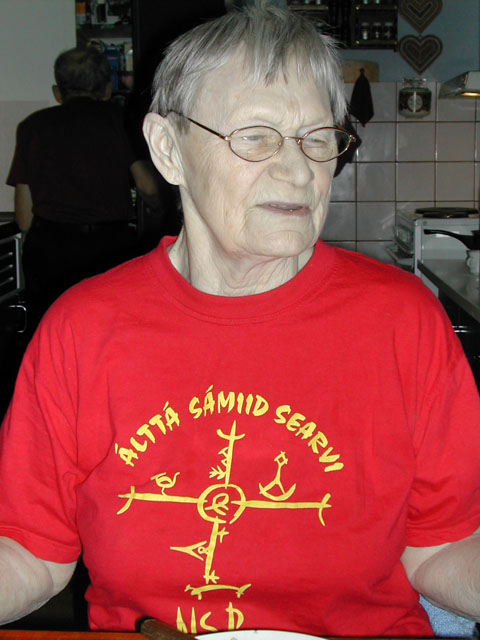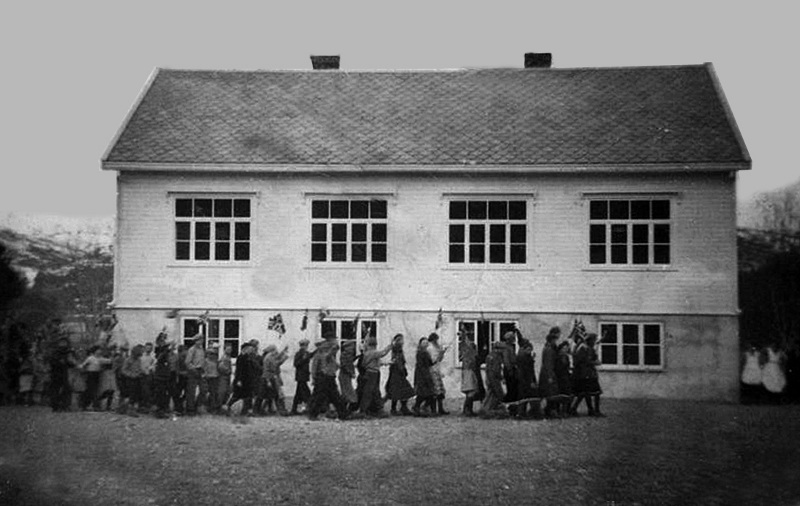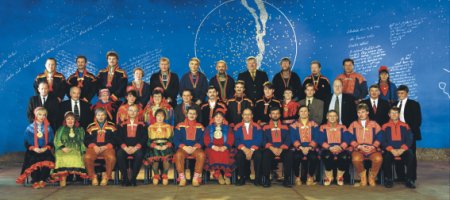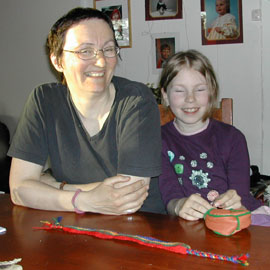 Sámegillii
Sámegillii
 På norsk
På norsk
Article in the book Sami School History 1. Davvi Girji 2005.
 Ruth Rye Josefsen, Alta 2003 |
Ruth Rye Josefsen was born in 1923. She grew up in Rafsbotn / Reaššvuotna in Alta, where she still lives. Here she has lived most of her life, except for the evacuation period in the end of the 2. World War and some years in Nordland in the 40's and 50's. She has a reputation as both public speaker and writer, opinionated on a wide range of issues, and most people in Finnmark have seen her writings in the newspapers. She is most famous as the leader of "Folkeaksjonen mot utbygging av Alta-Kautokeino-vassdraget" (People's action against the hydroelectric plant on the Alta-Kautokeino river) in 1979-80 and as a member of the Norwegian Sami parliament in its first election period (1989-1993). Locally and on a Finnmark county level she has been active in different organisations like Norgga Sámiid Riikkasearvi / Norske Samers Riksforbund (Norwegian Samis National Association), Norges kommunistiske parti (Norwegian Communist Party), Nei til EU (No to Norwegian membership in European Union) and Handel og kontor (Trade union of trade and office workers). |
In 1985 the historician Jens Petter Nielsen was assigned by Alta municipality to write a report on "The Sami strain in the population in Alta fjord". Drawing on old censuses he wrote about Rafsbotn: "Rafsbotn is ethnically, most known for a relatively strong Kven strain in the population. The censuses however show that the Sami element, at least in our century, was always stronger than the Kven." In 1930 as much as 80,2 % of the population in Rafsbotn was registrered as Sami, in 1970 this was reduced to 23,3 %, without there having been any substancial emigration or immigration.
Subsistence in Rafsbotn has been, as in many other villages in the fjords in Finnmark, based on small farms, fishing, hunting and gathering. From the 1920's there were many who worked in the slate quarry in Alta. This was appropriate seasonal work, which could easily be combined with other livelihoods. Ruth's father was one of those who worked in the quarry. Later on many have been working with roads and constructions.
- Most peoples in Rafsbotn were Laestadians [1], but not as strict as they often were in Alta. It was not usual for the children to be taken along to the assemblies at the meeting house. My parents did not go there, but I asked to go there together with my aunt, as I wanted to see how it was there. But there were no other children, and I did not go there again.
From 1899 to 1902 Anders Larsen was a teacher here. He was a Coast-Sami from Kvænangen and later he became the editor of the Sami newspaper "Sagai Muittalægje" (Newsteller). Larsen wrote the first Sami novel, "Beaivvi álgu" (Dawn) and the booklet "Mearrasámiid birra" / "Om sjøsamene" (About the Coast-Samis), which is partly based on what he had experienced in Rafsbotn. From Larsen's time as a teacher in Kokelv it is known that he taught in Sami and therefore clashed with the School Director. Larsen's work may have been one of the reasons why the number of people in Rafsbotn declaring themselves Sami increased from 1900 to 1930.
– The earliest I know of local school history, says Ruth, – is that my parents went to school here. I think that my father started in 1905 and my mother in 1908. At that time there was already a permanent school and all education was in Norwegian.
I myself started school in 1931. At 8 years of age. There were two reasons why I started a year later than most others. First, we were living far up in the valley and it was a long way to walk down to the school. Second, children of working people at that time could not expect to get more than 7 years of schooling. My father wanted that we should learn as much as possible, and he meant that I would learn more if I was a year older.
The school in Rafsbotn consisted of one classroom and the teacher was living at the other end of the building. The school was divided into three parts, but we had only one teacher in common. Therefore we went one week to school, then we were two weeks off. In most parents' opinion this was OK, because in the free weeks children could help the parents at home or in the quarry. The teacher whom we had during the first years was educated as a teacher and came from Tverrelvdalen (village in Alta dominated by immigrants from Østerdalen in Southern Norway). He considered himself better than the Samis in Rafsbotn and had little contact with the local population. Later we got another teacher who was excellent. But meanwhile there were many bad substitutes. I remember that one was expelled after having severely beatea a pupil . The general opinion was that Rafsbotn school was a terrible school with badly behaved pupils.
The teacher beat children with birch twigs and tugged the girls' braids. He took biblical wall charts and covered up the windows, so that nobody could see that he was beating the children. But he did not dare to touch me, because my father was known as one who dared to speak out. While we were at school, I remember that there was a new law telling that teachers no longer were allowed to beat pupils. (Folkeskolelova av 1936 - Act on primary school).
The teachers we had could speak neither Sami nor Kven. We got a clear message that at school we should only speak Norwegian. Though I am unsure as to who decided upon this policy. I can't remember if Samis or Kvens were ever mentioned in the schoolbooks or in the teaching.

| Rafsbotn school, 17.05.1937 (Photo lent by Sven Olsen) |
There has never been any specific Sami organisation in Rafsbotn. The most important local organisation was the sports club. The youth in Rafsbotn was known to be clever at sports and they often won competitions against the sports club in Alta. Then were subject to abuse such as "tjærrafinn" (Tar Lapp).
My first husband came from Kjerringøy in the county of Nordland. He often visited my father's family and said that my grandfather used to say: "We Sami do it this way". I remember, I was somewhat anxious about how my husband would react to the blunt assertion that we were Samis. It was not something which was openly discussed at the time.
The Alta Sami Association had just celebrated its 30-years jubilee, when we visited Ruth. She was wearing a T-shirt with the text "Alta Sámi Searvi 30". But when the Sami association started in 1972, there were no members from Rafsbotn. Immigrants from Inner Finnmark and South-Sami areas started this organising, but gradually native Alta-Samis joined. Ruth herself joined in the end of the 70's together with another woman from Rafsbotn, Idun Meli. They got themselves Sami costumes and "teased people", as she says, since it was not at all popular at that time to be a Sami publicly in Rafsbotn.
Idun Meli was a teacher in Rafsbotn, and the first to start teaching the Sami language. At first she had only one pupil and together with the pupil she had made a poster with drawings of different Sami costumes and put it up on the school wall. A journalist from the local newspaper Finnmark Dagblad then published an article with a photo of this poster, quoting Idun Meli's statement that most people in Rafsbotn had Sami blood. This provoked a hullaballoo in the village. The beautiful drawings disappeared without trace. Three boys from Rafsbotn went anonymously to the newspaper and declared, that it was not at all true that we were Samis, we did not want to be branded as such. In addition, they claimed, the first to settle in Rafsbotn, was a Dane.
- I know very well who they were, says Ruth. Two of them are my relatives, and they can not free themselves from a Sami background. One of them had a grandfather who was reindeer herding Sami from Karasjok. No, it was as if everything Sami should be washed away.
Even if many have admitted their Sami bakground now, there are relatively few in Rafsbotn who have joined the Sami census. Ruth is the only one among 7 brothers and sisters and Idun the only among 10, who is in the census. In contrast a search for German or Danish ancestors is quite common.
In 1968 she got the chance to take half a year of trade school in Tromsø. In 1972 she started studying academic subjects. It took a long time to complete, besides work and organisational activities, but finally she passed the exams nessesary for study at the university. For some time she was a commisionary for Narvesen (chain of kiosks with litterature), later she worked in the office of an electro shop until she reached the age of retirement. Only then did she begin to study Law at the University of Tromsø.
- But then I was elected into the Sami Parliament and I did not get time to study so much. But what I have learnt about law has been very useful to me.
 | 
|
| Ruth and Eva have both represented NSR (Norwegian Sami Association) in the election district Alta/Kvalsund in the Norwegian Sami Parliament. Ruth in 1989-93 and Eva in 1997-2001. Here are the representatives of the Sami Parliament 1997-2001, with Eva in the second row, no. 5 from the right.
(Photo: Harry Johansen) |
Eva has for many years been active in Sami politics and other political work and has among others been leader of the Alta Sami association. In the period 1997-2001 she was a member of the Sami Parliament, as a representative of NSR.
In contrast to her mother, who started school one year later than sceduled, Eva started one year earlier, as a 6 year old in 1967. The first six years she went to Rafsbotn school, after that Alta youth school (secondary school) and further education at what at that time was known as Alta gymnas.
At school in Rafsbotn I can not recall that we learnt anything about the Sami, at least nothing connected to our village. Most teachers were from outside. But one of the teachers was raised in Rafsbotn. I can remember that we were on a trip to a neighbouring village Ruoššaluokta (Russeluft) when I was in the 4th class. Then this teacher told that during the war there was a boy who fooled the Germans, so that they fell down a steep mountain here. Later I found out that this can not be true. If this had happened during the 2nd World War, it would of course have been publicly known. The story that lies behind this, must be the old Sami legend where the Russian Chuds were fooled and fell down the moutain. If that happened here, it can also explain the name Ruoššaluokta or Russians' Bay. In later years I have thought of this as one of the many cases where the history of this area has been falsified and reinterpreted so that the Sami content would disappear.
At the school in Rafsbotn there was one girl who spoke Sami. She had come from Guovdageaidnu (Kautokeino). She taught us a few sentence in Sami, such as "Atte munnje cummá!"
- Your mother has told that when youth from Rafsbotn came to Alta, they were called "tjærrafinn" (Tar Lapp) and similar depreciatory expressions dismissive of the Sami. How was that when you were growing up?
- Then there was nothing such to be heard. There was no longer any common understanding that there were Samis in Rafsbotn, neither among the people in the village, nor in the neighbouring villages. I myself did not have any clear concept of what I was in my childhood.
- I remember that in secondary school there was a teacher who asked if anybody in the class understood Sami. One pupil who spoke Sami almost had to be forced to admit it, she did not want to talk about it. It was not admireable to know the Sami language, rather the opposite.
16 years old Eva began a Sami language course. Håkon Henriksen, who was the teacher, was one of the leaders of the Peoples action against the development of hydroelectric power plant in Alta–Kautokeino. Later Eva has learnt more Sami, so that she can understand and speak somehow. But in public, she still prefers to express herself in Norwegian
After further education Eva studied Economics and Administration at Finnmark College. There was absolutely no mention about Sami affairs. Later she studied political science at University of Tromsø. There was nothing about the Samis in the curriculum at this school either, neither at first, nor second level (grunnfag and mellomfag), but now the students demanded, that it should be. Until the master level Eva had not experienced to get anything about Sami affairs in the curriculum.
In conclusion one may say that a Sami pupil / student from a Sami village in Coastal Finnmark in the period 1967-2001 could go through 18 years of education with minimal information about her own people. No wonder that when Eva should write her master thesis, she chose to write just about what those who are planning education and other public tasks, know about Sami affairs. Then she found, not unexpectedly, that both in the Ministry of Education and the Ministry of Fisheries most of the proceedings of importance for Sami regions had been carried out without any evaluation of how the decisions would influence Sami interests.
Today her chief interest is to ensure that her daughter and other children in Alta with Sami background will be more familiar with Sami culture and language than she herself has been.

| Eva and Irja Marie Josefsen, Alta 2003
(Photo: Svein Lund) |
From before Irja learnt to speak she was in a Sami kindergarden and when she had started speaking, Sami and Norwegian came simultaniously. When she started school, she spoke both languages with roughly equal fluency.
At Komsa school in Alta Irja follows the curriculum for Sami as first language. The first language pupils are a group of 6 pupils in 3rd and 4th class. One might assume, that first language means education in Sami. But that it not the case in Alta. There Sami as first language means only that she has got Sami as a subject from 1st class and that the education in Sami language as a subject in taught in Sami language. [2] All other subjects are taught in Norwegian, and then the pupils follow their respective classes. Up to the present in Alta there has not been offered any education in other subjects through Sami.
Irja is not very keen on being interviewed, so it is mainly her mother who answers for her. She listens carefully, so that she can check that I don’t write anything wrong. It is not only the language which is Norwegian in all other lessons than the Sami language subject. The content is also according to the national curriculum. As Alta municipality is not a part of the management area of Sami language [3], the national curriculum is used for all schoolchildren. It means that even pupils with Sami as their first language do not utilize the fact, that there exists a Sami curriculum for primary and secondary school.
- Do you learn anything about Sami affairs in other lessons than the Sami lessons?, we ask Irja.
- We have a Sami riddle in our Norwegian book, but apart from that, there is nothing.
Also in the Sami language lessons there is minimal content about the Coast-Samis, as the Sami teacher comes from Inner Finnmark and mainly knows that environment. When there also are people from Inner Finnmark writing the schoolbooks, there is not much to connect Sami education to local society and to the background of most of the pupils.
Both as a mother and as a member of Alta Sami Association, Eva has been involved in Sami education in Alta. The School Office had been completely negative, but in later years it somewhat improved. In any case the Sami education is still treated as a blemish, not as a natural part of education at the schools the pupils belong to. First the rest of the timetable is planned, then one has to try to adapt the Sami lessons to it. There is still a widespread opinion in the municipality, that Sami education is a question of an offer to pupils from inland, not to Alta's own Sami population.
Among the parents there have been a reange of opinions as to whether one should demand an autonymous Sami school district, or if it is better that the pupils get Sami education at the schools to which they geographically belong.
At Rafsbotn school, where Ruth and Eva went, there has now been Sami education since the early 1980's. Today (2003) there are about 15 pupils who have Sami as a subject. That is about one tenth of the children at the school. Even if these numbers are an increase from priginally one pupil, it is still only a small minority of parents with Sami background who choose that their children shall learn the language.
[1]
More articles from Sami School History 1
[2]
[3]